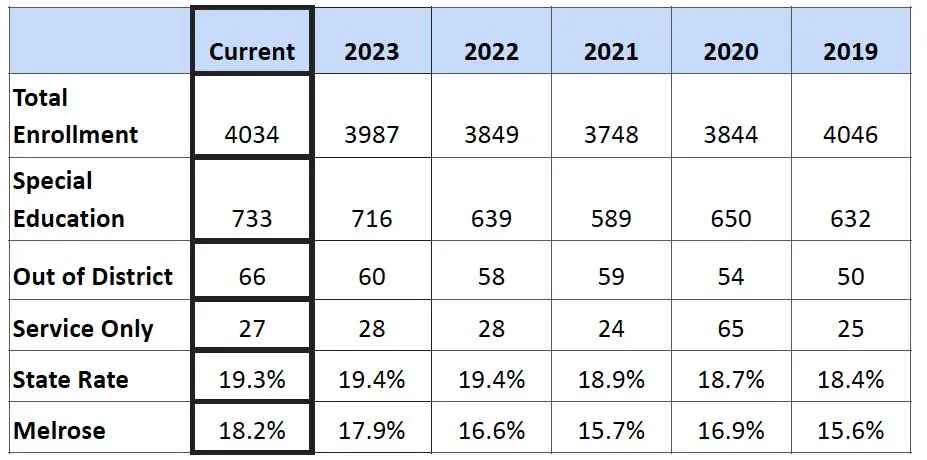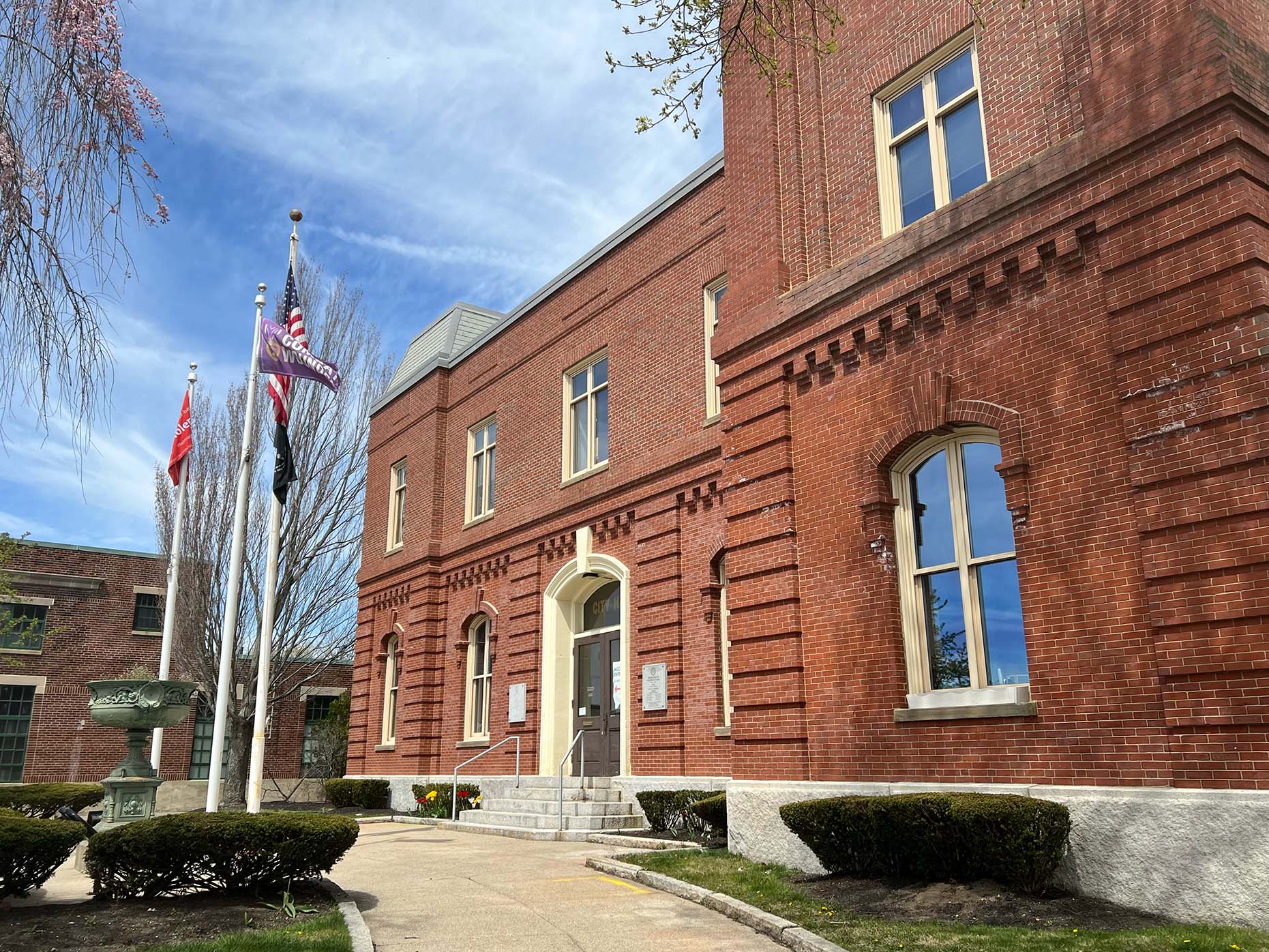School Committee Votes on FY25 Budget
By Sandy Dixon
The school committee met twice this week to continue the difficult decisions ahead of them as they prepared to finalize and vote on a balanced budget for FY25. The budget as original proposed required cuts of approximately $4.2 million dollars, and the public again voiced their concerns about teachers and directors who are slated to be let go.
More on that soon, but first, some very good news:
The Melrose Public Schools and City of Melrose have received a clean audit report from an outside, independent accounting firm that covers the school year, 2022-23. This is a detailed project that consists of a review of documentation, and has taken months to develop. The audit shows no material findings: none, zilch, nada.
As was described on April 23, “every dollar has been traced back to its original source (across over a dozen categories) to serve our students. This is a major accomplishment for our Director of Finance Ken Kelley and the school business office, as well as our city colleagues and partners.” For those fearing that money is being mismanaged, this report goes a long way to dispelling those fears and to spelling out, in clear terms, that finances are accounted for and appropriately spent as it has been budgeted and assigned.
Enrollment and Increased Needs
While overall enrollment in the Melrose public schools dipped during the pandemic, it is now back to pre-pandemic levels, and is expected to continue to rise for the foreseeable future. Strikingly, but not surprisingly, before the pandemic, 15.6% of kids qualified for special needs, now that number is 18.2%.
In particular, the out-of-district placements have risen significantly, such that now 66 students require out-of-district tuition costs and transportation to these placements, all of which come at significant cost.
Here’s the data:

Why Does Level Funding Not Mean Level Services?
Let's take a look at last year’s Melrose Public Schools budget.
- “Non-salaried expenses” for each school (meaning costs for things like instructional aid, school materials, and general supplies) increased from FY24 to FY25 by $733,500.
- Special education non-salaried expenses (out of district tuition, transportation, evaluation supplies, and general special education supplies) increased by $500,000.
- If we add to this a 3.3% salary increase for the 279 (approximately) FTE teachers with an average salary of $76,000 (from the latest figures available), this adds an additional $800,000.
Adding these figures gives us an increase of $500,000 + $800,000 = $1.3million in expenses, without any additions of staff or services (in other words, level services).
If we then factor in $150,000 additional funds from the state, this leaves the city with an additional $1.3 million - $150,000 = $1.15 million increase in the funds that are needed to cover the same level of services, but are not covered by the state.
State Funding and the Cost of Inflation Revisited
As has been noted before, the school funding formula includes three sources, such that the total school budget = city revenue + state funding (Chapter 70) + Offsets (fees).
Inflation has been very high for the past few years and, as reported by the Boston Globe, “actual inflation for schools was 8 percent for this fiscal year and 7 percent for the last fiscal year, according to the superintendents association.” The funding formula used to calculate state aid for school districts, however, caps inflation calculations at 4.5%. This is not enough to keep up with the drastic cost increases seen by schools across the state, meaning that the state aid many cities and towns receive is not enough to address rising costs.
Using this state formula, more than half of Massachusetts cities and towns will receive the bare minimum increase in state aid for the FY25 year. Melrose is one of these cities, and our increase in Chapter 70 funding is a mere (approximately) $150,000 this year, or slightly more than a 1% increase from last year’s amount.
In my last article, I reported that level funding of our schools would not equal level services, meaning that the same amount of funding for FY25 would not result in the same services as FY24, and inflation can help us understand why this is - see the sidebar for details. These numbers are very broad estimates, but they can help us understand the impact of inflation and cost of living increases, and the lack of appropriate state-level funding, on the budget.
On To the Cuts...
Superintendent John Macero noted this week that, “Just one rough year can impact a student for more than that year.” That is, one year with a class of too many students or not enough services can have long-lasting consequences that continue to negatively influence a student throughout their education. That being said, cuts in services need to be made...so where to begin and how to make them?
On April 23, the superintendent outlined the specific staff that would be eliminated, including the positions from each of the schools. Administrators, directors, teachers, and paraprofessionals are all included in the list of 58 positions being reduced through a mix of transfers to other positions, elimination of positions, expected retirements or resignations, and new positions created but not filled, in this initial round. The cuts were sobering, and include beloved teachers and directors that were mentioned by name by members of the public who spoke on the impending loss of a favorite staff member.
The technology and professional development budgets would both take huge hits and the district would lose many materials that are currently included in curriculum or as aspects of a student’s individualized learning plan, such as the iReady program, Newsela, and other online programs. Staff would no longer have access to Inclusive Instruction Academy and the district would no longer have access to teacher coaching and consultation currently offered for these programs.
Dr. Jennifer Turner, the Assistant Superintendent for Teaching and Learning, is concerned that cuts to the services Melrose provides to its students with disabilities may result in the district's inability to meet those student's needs. This, in turn, would result in more out-of-district placements (it is legally mandated that if a student’s needs cannot be met by the district, the student must be placed out of district), which are simply more expensive to the district. So, in these cases, cuts may actually result in higher costs, not lower.
How a Language-Based Program Can Save the District Money
A language-based program saves the district money as soon as two students are kept in district rather than go out of district. The total cost of this program will be $142,000 (which consist of teacher salaries and speech/language costs), which is a per-pupil cost of $17,8000 (for 8 students in the program), and $28,300 (for 5 students in the program).
Comparatively, each student that is placed out of district costs (approximately) $92,000. Two students out of district is a $185,000 expense (2 x $92,000), while three would be $277,000 (3 x $92,000). As this math shows, Melrose is saving money as soon as two students use this in-district program rather than be placed out of district:
$185,000 (Two out of district students ) > $142,000 (Cost of in-district program)
Specifically, there was a request for the reconsideration of establishing the language-based learning program at Hoover Elementary School for grades 3-5. Superintendent Macero and Assistant Superintendent of Pupil Personnel Services Cari Berman made a compelling case that, if a student needs this program and it is not available in-district, this student will then require a (very expensive) out-of-district placement. That is, this is an example of a program that, once it is begun in Melrose, will result in cost savings, and the money spent now to set it up will quickly be recouped.
After the first night of the presentation of cuts, the committee adjourned to return two days later with a further analysis of the staffing situation. In the April 23 meeting, Jen McAndrew had suggested returning to the fee schedule, and presented increasing athletic fees by $50 with an adjusted family cap, increasing extra curricular fees and increasing the fees for Education Station.
These increases in athletic fees will bring in an additional $45,000, with other extracurricular fee increases adding $15,000, and Education Stations bringing in an additional $100,000. This is a total of $160,000 added to the budget. Eliminating the athletic secretary position provides a saving of $34,000 (some functions will still be needed elsewhere). These additional funds added an additional $205,000-$210,000 and allowed two teachers slated to be cut to be spared.
As the budget stands, this means transferring up to 13 positions, eliminating 5 directors and administrators, and eliminating 15 current teachers within the district. It also means not filling positions when someone decides to retire or resign, which of course increases class size. Here’s the break down:
- 4 current positions not being replaced due to (already known) retirements or resignations
- 26 new positions created will not be filled
- Increased class sizes at all elementary schools
- Increased class sizes at the high school
- Unfilled new Special Education positions at elementary and high schools
- Instructional coaches eliminated
- Restructuring administrative roles and responsibilities which will impact teacher evaluations
- Inequity of elementary assistant principal services (some elementary schools will maintain an assistant principal position while others don't)
The school committee then voted on and approved a $47.2 million budget that included these program and staffing cuts. The next step is for the mayor to present her budget numbers to the city council on May 6.
As stated earlier, she will ask the city council to vote on an override, with specifics on the amount and what it will fund, in the upcoming weeks. If the city council approves an override, the expectation is for a June vote so that, if passed, funding will be available for FY25. This would make the above reductions and restructuring unnecessary.
If the override does not pass, the cuts outlined above will go into effect.
“We Need Help”
This budget is $51 million - $47.2 million = $3.8 million short of the superintendent’s proposed budget presented earlier, and the school committee, almost to a person, reflected on the difficulty in making this vote and understanding what it means to the district. While it is less than the original $4.2 million originally proposed, it is still significant and comes with increased fees. Jen McAndrew stated, “Where we are now is uncomfortable and sad. But it is not surprising. Public education is woefully underfunded, while it is the last best place for all services for kids. As Katherine Clark [former Melrose School Committee chair] has said, when it comes to conversations like this, we are often faced with a ‘buffet of bad options.’ The hope we can share is that we need sustainable, repeatable solutions. Hopefully tonight has helped in that discussion.”

Melrose City Hall
For anyone who has been attending school committee meetings for any length of time, and for any number of budget cycles, this funding crisis and structural deficit is very familiar. And now, it is occurring not just in Melrose, but all across Massachusetts.
Superintendent Macero implored, “It’s up to us as a community to help those were displaced [during the pandemic], and give them what they need.” The state is not helping, instead they are requiring communities to fix what has been broken and provide help to their students who were deeply impacted by the pandemic.
McAndrew continued, “Costs are going up across the board, as you have heard tonight. And needs are increasing, as we have discussed many times--both in terms of enrollment since the pandemic and complex needs of the student body. But our ability to respond is constrained by a law implemented in a very different time by an electorate that no longer represents us.”
As Superintendent Macero said, “We need help.” That help right now can only come from the community.
This is the most collaborative budget negotiation process seen by Jen McAndrew in her 7 years on the school committee, with joint communications with the mayor and the superintendent, and communication with the city council as this process unfolds. That is a hopeful sign, and reflects the municipal government’s unity in understanding the problem faced by the city. There is not a single government official pointing a finger or blaming anyone.
And while Superintendent Macero provided Melrose with a needs-based budget that mapped out how he, and many others, believe Melrose should fund its schools, in ways that clearly identify the values and priorities that so many have for our schools, he acknowledged that we may not be able to meet the moment for our students.
However, there is a path forward.
As Seamus Kelley stated, “At this point, as a committee and a community, we have two options: We can agonize or we can organize.” He continued, “I’m going to choose option two and help organize people to support the operational override.”
What Did the 2019 Override Do?
In 2019, Melrose voted on a $5.18 million Proposition 2 ½ override. This raised the tax levy above the minimum 2.5% increase allowed annually, to increase the revenue received by the city for that year. Many people have asked about the status of the money raised by this vote, and I have written about this in a recent article that is worth summarizing again here.
First, it is important to understand that a Proposition 2 ½ override is typically used to pay for recurring operational expenses in a city or a town. That is, these funds are part of a one-time, higher than normal tax increase, but this new tax levy is the new base upon which future tax increases are calculated.
This increase in the tax revenue of a municipality is used to pay for ongoing costs for running, for example, the school department or increased staffing in a city department. That is, the majority of the funds raised in the override is used to fund an increased expense in the operating budget and, therefore, continue to fund these services today.
The City of Melrose published, in September 2019, a School Department report on the actual impact of the override funding. The override funding reflects specific investments the city and its residents agreed to make, in an ongoing way, to the school budget. Highlights of the override investments, at that time, included:
- Multiple teachers and paraprofessionals at the high school (ELL, science, math, special education) and a guidance counselor to restore the ratio of students per guidance counselor to the recommended level.
- Restoration of the team model at the middle school, along with additional teachers and a paraprofessional.
- Teachers and administrative staff at elementary schools to support a growing school population.
- Increases in funding to support the three-year contract that went into effect on July 1, 2019.
- Restoration of six subject-area Director positions for grades 6-12 to oversee curriculum, instruction and evaluation, and a K-12 Art/Music Coordinator position.
- Supplies for elementary art, physical education/wellness, health and library.
These positions, and their costs, continue to be maintained in the school budget. The override funds continue to provide revenue for the following positions to be provided by the Melrose Public Schools, as seen annually in:
- $250,000 to replace the annual revenue from the Beebe School rental to the SEEM Collaborative at the conclusion of their rental agreement.
- $750,000 to fill the funding gap caused by the School Department’s structural deficit.
- $425,000 for instructional supplies and materials.
- $1,850,000 to fund raises and other provisions of the teachers’ current contract that was settled in FY20.
- $438,156.50 to pay the cost of insurance and benefits for school employees carried in the City’s annual operating budget.
- $1,466,843.50 funds 28.5 school staff starting in FY2020.
In other words, the override investment continues to provide needed funds for our schools, and it is seen in many way, most directly in 28 staff members in the district.
It is worth highlighting the last line: 28.5 new staff were hired in FY2020 because of the override. This week’s budget deliberations will result in a cut of 15 teachers and 5 administrators and directors. If you want to see the continuing impact of the 2019 override, it will be felt, in part, when 20 staff members do not return in September.
We’re all in this together, Melrose.
Read this piece on Sandy's substack here.

Follow Us: